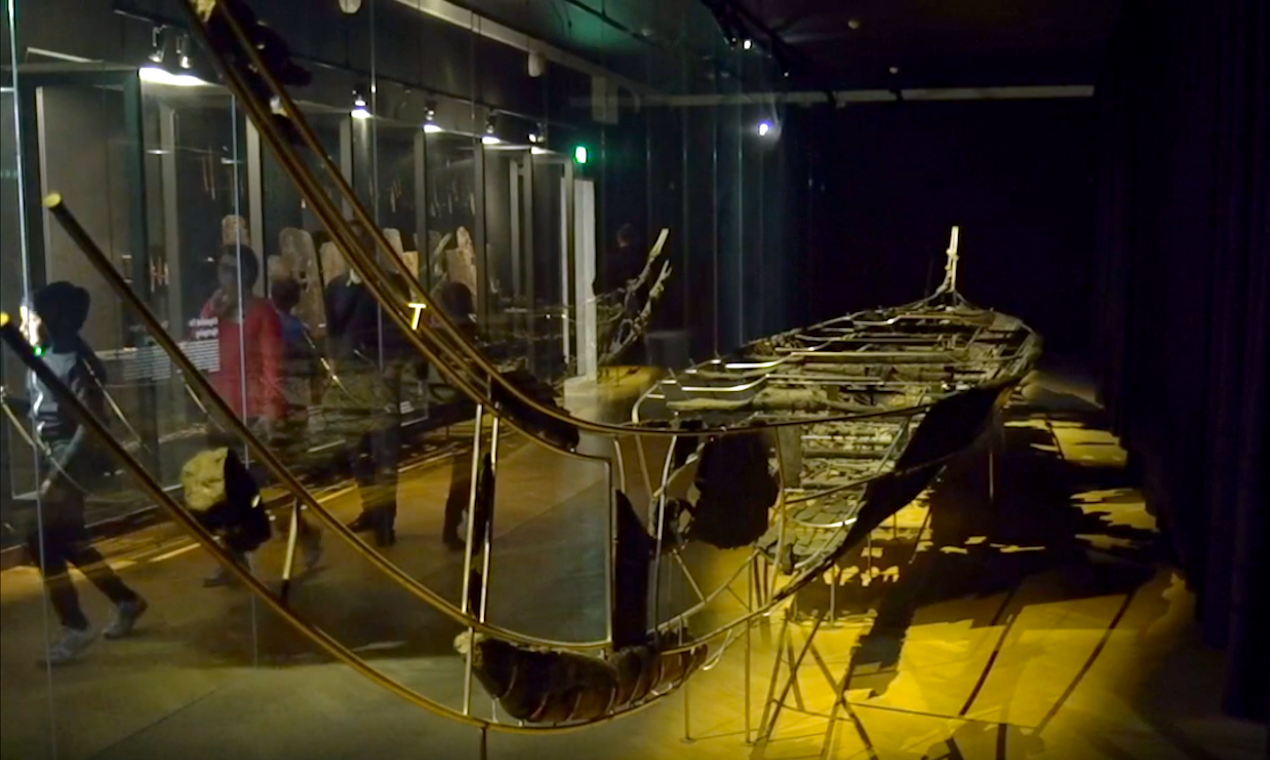The Hjortspring-Boat
The boat we wanted to build
The boat is the Hjortspring-Find most impressive single piece and is Scandinavia's oldest, so far found, plank-built vessel.
Basis
G. Rosenberg's find descriptions and Fr. Johannesen's derived drawings are the basis for:
- Rosenberg's scale model, as seen in Reconstructions
- The National Museum's re-establishment of the find, see below
- Our reconstruction of the Hjortspring boat

The components of the boat.
F. Kaul: Da våbene tav, fig. 11.
It is a canoe more than 19 m long, built of a bottom plank and of a side and gunwale plank on each side, the ends of the planks are held together by two bow blocks.
This provides a keel-free, round-bottomed vessel. The bottom plank and the railing edges are extended at both ends in two 2 m long upwardly bent horns (see picture above).
The boat is mostly made of linden wood, the bottom plank and the bow blocks are locked together by a vertical oak plank (locking plank), likewise the horns are held together by a piece of oak, the oak pieces are tapped into the horns and fixed with oak nails.
An arrangement of 10 rib-frames, made of a seat plank of linden wood, two columns and a crosspiece of ash, all held together by a hazel branch, which is tied firmly to cleats carved into the bottom and side planks. Cords for tying are made of linden bast. The same kind of strings are used to sew the planks together, no metal is used anywhere in the boat!
The boat is 13 m long and 2 m wide inside, 0.7 m high amidships and the plank thickness varies from 3 cm at the bottom to 1.5 cm at the railing.
The craftsmanship has been so good that the weight has only been approx. 500 kg.
With a crew of 22 men - 19 paddlers, captain, helmsman and pacemaker (drums) - and their equipment on board, the total weight has been approx. 2,500 kg. The draft has then been approx. 30 cm.
What else was
The Hjortspring find is much more than the boat itself, we have also gained a broad knowledge of the pre-Roman Iron Age weapons and equipment.
The following were found in more or less complete size and shape:
- More than 50 linden shields, it is the largest total find of preserved shields from all of Europe's prehistory. They all have the same basic shape with lengths from 61 to 68 cm and widths between 29 and 52 cm.
There are remnants corresponding to there must have been between 60 to 80 shields. - At least 169 spearheads, of which 138 were of iron - of very different shape, from 10 to 13.5 cm long - and 31 of legs or notches. The longest spear shaft was 197 cm long.
- 11 swords of very different shapes, but all single-edged and gripping tongue lying in the central axis of the sword.
- It was during the excavation found rust prints of small thin iron rings, this layer has acc, Rosenberg covered 20 to 24 m², enough for 10 to 20 chainmail, the oldest known throughout Europe. They must be assumed to have been imported from the Celts in Central Europe.
- The first examples of turned wooden parts in northern Europe, small cans approx. 10 cm in diameter.
Many different wooden parts were found for use in sea transport.
As the original material looks now
Exhibition of the find at the National Museum
- 1937. The first exhibition of Hjortspringfundet - alum-glycol conservation.
- 1965. The boat was taken down due to problems with conservation. It was separated, preserved and unpacked.
- 1986-1988. Due to lack of financial resources, the boat was only rebuilt during this period.
- 1988. The boat and the other objects were exhibited again in a newly decorated exhibition space. Fl. Kaul published his book: Da våbnene tav, and Fl. Rieck & O. Crumlin-Pedersen: Både fra Danmarks Oldtid.
- 2003-2004 . The exhibition Sejrens Triumf was opened with the borrowed Nydambåd as one of the attractions and dealing with war booty victims.
The Hjortspring-Boat and Tilia Alsie mentioned [ p. 212 - 222 ].





